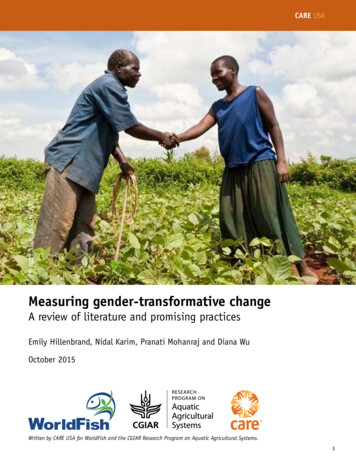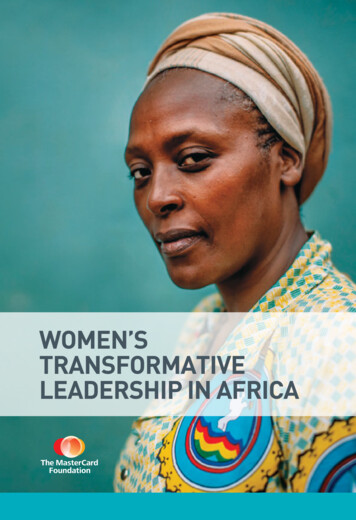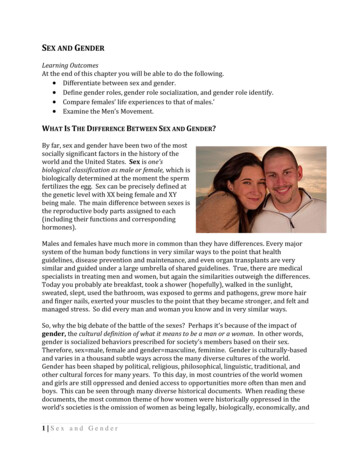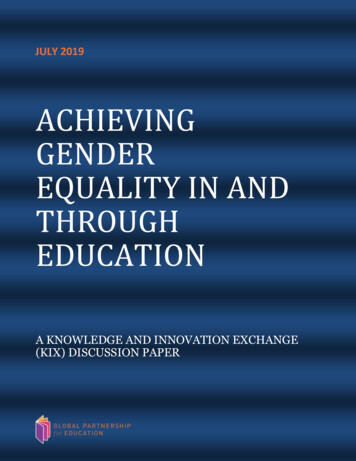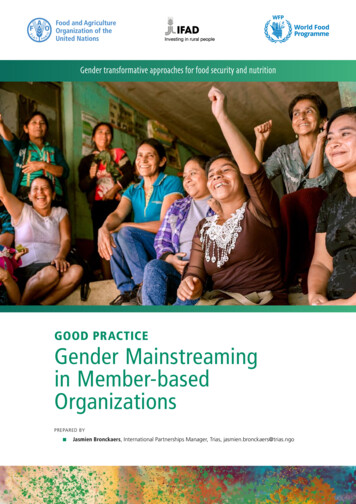
Transcription
GOOD PRACTICEGender Mainstreamingin Member-basedOrganizationsPREPARED BYJasmien Bronckaers, International Partnerships Manager, Trias, jasmien.bronckaers@trias.ngo
2Gender transformative approaches for food security and nutrition – Good practiceSECTION 1 OVERVIEW OF THE METHODOLOGYName of the methodologyToolbox for Gender Mainstreaming in Member-based OrganizationsCountries with implementation experienceThe methodology was created in El Salvador, with testing afterwards in Guatemala and the Philippines.The Latin American and Caribbean Network of Fair Trade Small Producers and Workers (CLAC) isinterested in extending the methodology to all other countries in the network. At this moment, initialactions have started in several countries including Bolivia, Colombia, Costa Rica, Ecuador, Mexico,Nicaragua and Peru.Start/end date—— 2014–2016: design and implementation of the roadmap by Trias Central America with fourpartners in El Salvador—— 2017: methodology development, including understanding the mechanisms of changeand detecting any trends or coherence in various processes, and integrating them into themethodology—— 2017–2018: roll out in different countries of CLAC (e.g. Guatemala, Mexico, Nicaragua)Lead organization sponsoring the development and implementation of the methodologyTrias, a Belgian development non-governmental organization (NGO) with experience dating back to the1960s, works with a worldwide network of partners to support the self-development of disadvantagedfarmers and small business owners in 14 countries across Africa, Latin America and Southeast Asia.Working with farmer organizations and entrepreneur organizations is part of Trias’ DNA, as it is backedup by three rural and three entrepreneurial Belgian membership-based organizations.Trias cooperates with 140 farmer and/or entrepreneur organizations worldwide, supporting over 3million family farmers and small-scale entrepreneurs. Trias specializes in organizational strengtheningbecause strong organizations facilitate joint action towards social and economic empowerment, povertyalleviation, wealth creation and the well-being of their members.Purpose of the methodology and the domains of gender inequality that are addressedThe methodology works towards individual empowerment of women and men, in parallel with anintentional change process of organizational structures towards gender equality. The methodology worksat different levels: individual, enterprises/value chains and organizations. The household-level applicationis under development.The integrated approach, which is self-led by the leaders of an organization, works to reduce the structuralbarriers for gender equality by working on three main interrelated pillars:—— the institutionalization of gender equity,—— the empowerment of women, and—— the building of alliances between women and men.Contribution of the methodology to wider development/organizational/project goalsThe methodology provides a pathway for inclusive organizational development. It enables memberbased organizations and other types of organizations, such as NGOs, to work on their sustainability byaddressing inclusivity and gender equality as a major strategy in order to respond to the differentiatedneeds of their membership. Gender equality is part of an organization’s sustainable development.
Gender Mainstreaming in Member-based OrganizationsThe methodology facilitates:—— the inclusion of youth and other minority groups—— innovation and economic initiatives for women and youth—— improvement of environmental sustainability of participating organizations—— improvement of democratic participatory decision-making—— improvement of social sustainability towards the communities—— the empowerment of women, youth and men at individual, household, organizational andcommunity levels.Target group—— Men and women (adults and youth) who are members of producer organizations and interested ininclusive organizational development, and female leaders in producer organizations.SECTION 2 IMPLEMENTATION ARRANGEMENTSKey entry points for applying the methodologyThere are three entry points:—— producer organizations—— leaders (men and women) of producer organizations and leaders of CLAC—— female leaders.The starting point is the interest of an organization to work on their gender equality and organizationalinclusiveness.Implementing partnersCLAC is a fair trade platform for Latin America. It works as an umbrella organization with a membershipof close to 340 000 family farmers (producers) organized into 840 producer organizations in 24 countriesin Latin America.Process of and criteria for selecting facilitators/champions/mentorsThe methodology is based on self-directed processes that can be replicated internally. The process is notalways linear. The two main elements are described below.—— Each organization forms a ‘pro-equity committee’, comprising members of the organizationat different levels. It is important to assure a good mix of men and women, adults and youngpersons, who represent the formal leadership and members from the membership base. Preferablya technical person with competences on gender issues is also included. These committee membersare the promoters of the organizational process.—— For the empowerment of women, there is a selection of female leaders. They are formal leadersbelonging to the board and/or other women who are leaders in the community but may notnecessarily have a formal mandate. These leaders participate in the ‘female leadership school’.After completing a training for trainers’ module, they replicate their experience within theircooperative with other women. Criteria for these women leaders are: openness, basic literacy,volunteer spirit and commitment towards the strengthening of their organizations, a respectedposition in the cooperative and community, availability of time, and decision-making over theirown time investments.3
4Gender transformative approaches for food security and nutrition – Good practiceTraining of facilitators/champions/mentors—— Roadmap for institutionalization of gender within member-based organizationsTraining is done in groups, with selected leaders and technical staff to introduce the toolbox. Itis important to have a good mix of men and women, adults and youth, and representatives fromdifferent levels of the organization. A mix of organizations makes it more interactive and createsmore learning experiences. Frequently the selection of the members of the pro-equity committeeis made from this group because after the training they have a clearer understanding of themethodology.—— Topics–– Introduction: concepts of gender, human rights, organizational development, inclusivity–– Reflections on the SWOT (strengths, weaknesses, opportunities, and threats) analysis of theorganization regarding gender mainstreaming, the actual situation and the vision for the futurerelated to gender equality using experiential techniques–– The 20 steps of the roadmap are analysed and adapted to the interpretations of the participants(see matrix and list below)–– A personalized roadmap with the steps selected by the participants in relation to their needs,existing experiences, progress and ambitions for the future—— Duration: A three-day workshop—— Documentation to promote learning: Experiences are recorded to promote reality-based learningwith the group of people who started the process.—— Trainers: Trias staff and experienced trained staff of partners facilitate the workshop. Triasadvisors and/or specialized staff of partners provide follow up for further implementation,with frequent discussion groups among the different partners and the management of theorganizations.—— The female leadership school has three parts–– concepts of gender, human and women rights–– economic initiatives of women–– training skills and abilities to be replicated among other women.—— Duration: Nine months in a modular system, with 9 sessions of 12 hours each, or an intensive6-day training course for modules 1 and 2, and an additional course for the third training oftrainers session—— Trainers: Trained staff of Trias partners and CLAC—— Topics–– Module 1 – Breaking the ice, introduction–– Module 2 – Human rights and identity of gender–– Module 3 – Leadership–– Module 4 – Self-esteem–– Module 5 – Political participation–– Module 6 – Self-esteem of the women–– Module 7 – Economy for life–– Module 8 – Sexual division of work–– Module 9 – Ideas of association to give potential to the economic autonomy of women–– Module 10 – Methodology and group facilitation
Gender Mainstreaming in Member-based OrganizationsSECTION 3 IMPLEMENTATION CYCLEKey steps in the implementation cycle—— Steps in gender mainstreaming roadmapThis process is led by the members of the pro-equity committee who have been trained in theprocess. The pro-equity committee follows the 20 steps with the members of their organization.Gender mainstreaming trajectory steps1234567891011121314153 YEARSMONTHS16 17 18 19202122 23242526272829 30313233 34 35Pillar 1: Institutionalization of gender equitySTEPSStep Step12StepStepStepStep3456Step Step7StepStepStepStepStepStep111213181920Step StepStepStep10 1011128Pillar 2: Empowerment of 51920StepStep1920Pillar 3: Building alliances between women and �— Step 1. Organizational dialogue meetings to achieve consensus on the mainstreaming trajectory(Pillar 1).—— Step 2. Creation of structures for equal opportunities and gender equity (Pillars 1, 2, 3).—— Step 3. Training and initial awareness raising processes (Pillars 1, 2, 3).—— Step 4. Organizational (self-) assessment regarding equal opportunities and gender equity (Pillar 1).—— Step 5. Sharing assessment results on equal opportunities and gender equity (Pillar 1).—— Step 6. Elaboration of a gender mainstreaming plan (Pillar 1).—— Step 7. Design a system of indicators to monitor the mainstreaming plan (Pillar 1).—— Step 8. Design and develop a communication plan for equal opportunities and gender equity(Pillar 1).—— Step 9. Training school for female leaders (Pillar 2).—— Step 10. Creation and strengthening of committees for adult and young women (Pillar 2).—— Step 11. Elaboration of the Equal Opportunities and Gender Equity Policy (EOGEP) (Pillars 1, 2, 3).—— Step 12. Gender budgeting (Pillars 1, 2, 3).—— Step 13. Elaboration of the EOGEP action plan (Pillars 1, 2, 3).—— Step 14. Development of services specifically for women (Pillar 2).—— Step 15. Elaboration of agendas by and specifically for women (Pillar 2).—— Step 16. Training school for male leaders (Pillar 3).—— Step 17. Creation of structures for equal opportunities and gender equity at local level (Pillar 3).—— Step 18. Review the organization’s strategic and policy documents (Pillar 1).—— Step 19. Exchange experiences and share good practices (Pillars 1, 2, 3).—— Step 20. Monitoring and evaluation of the EOGEP and its action plan (Pillars 1, 2, 3).—— Female leadershipThe women who have been trained replicate these experiences with other women in theirproducer organization.Tool 2/3/45
6Gender transformative approaches for food security and nutrition – Good practiceAverage length of the implementation cycleIt generally takes three years to implement the roadmap for gender mainstreaming and transformbehaviour and organizational culture. The timeline varies depending on the starting point of eachorganization.Graduation from the methodologyWork is in progress for the accreditation of trainers and facilitators.SECTION 4 MONITORINGMonitoring systemEach organization and level develops its own milestones to monitor the progress. Although they all tendto be very similar, it is important they formulate these milestones themselves.Collective learning is part of monitoring. Documentation and inter-organizational discussion groupsencourage participants to share results and failures, and adapt their strategies.IndicatorsWork is in progress to design of a set of impact indicators at the individual, enterprise/value chain andorganizational level.—— Organizational–– Number of women in decision-making positions (board, committees, management) in producerorganizations–– Gender inclusivity policy in the organization defined and applied–– Number of women involved in economic initiatives–– Number of services targeting specific groups, such as women and young people (e.g. credit foryouth or small pensions for elderly people who let their grandchilden become members)–– Participatory monitoring and evaluation systems with data disaggregated by sex and age–– Strategies developed based on needs and satisfaction measurement of women–– Norms, attitudes and values are gender-sensitive–– Allocation of resources to learning and systematization–– Positive actions towards women are an explicit part of the intervention strategy of theorganization—— Individual empowermentMeasurement of empowerment is based on Women’s Empowerment in Agriculture Index (WEAI):–– Production (capacity and power to influence)–– Resources (power to decide over resources of the producer organization and in the household,access to credit lines)–– Income (control over income, increase in income, number of women with an income)–– Leadership (representative roles)–– Time (reduction of workload and/or responsibilities, increase in personal time)SECTION 5 Main items of expenditure—— Training activities (including staff for training), exchanges, learning sessionsTotal budgetNot availableBUDGET
Gender Mainstreaming in Member-based OrganizationsSECTION 6 RESULTSNumber of beneficiaries reachedCLAC represents 332 553 family farmers, of whom 24% are women and 5% are young persons. Between2014 and 2018, CLAC members participating in the methodology totalled 3 750 (54% women and 46%men) across 14 countries.The methodology was initially developed in El Salvador, where the Asociación Coordinadora Salvadoreñade Pequeños Productores Organizados (CESPPO) represents five producer organizations with 1 436members, of whom 17% are women and less than 1% are under 29 years old.Main changes attributed to the methodology—— Organizational changes within CLAC, CESPPO and producer organizations–– Visible adaptation of gender approach by staff–– Increased participation by women in different levels of the organization (decision makers andtechnical staff)–– More representation of women at the board level (although not always with real participation)–– More women (young and adult) included in training activities, especially about leadership andeconomic empowerment–– More women involved in income-generating activities–– Increased decision-making power of women (although not so clear for youth)–– Gender and inclusion of youth policies in ‘living’ documents–– Development of functional tools and instruments to promote gender equality within CLAC–– Competent specialized staff to promote gender within the CLAC network–– A significant proportion of the budget allocated for gender mainstreaming in CLAC–– The collective learning spaces are valuable spaces to guide, follow up and co-create–– Installation of gender committees in CLAC, CESPPO and cooperatives–– Incorporation of gender indicators in CLAC’s strategic plan–– Cyclical sensitization processes increased the number of allies for gender mainstreaming–– Gender mainstreaming became an essential part of Fairtrade policy and is considered asimportant as any other standard of the certification.—— Outcomes in CLAC–– Use of non-sexist language–– Gender focus incorporated in programme and strategy development–– Youth and women in boards of CLAC, CESPPO and cooperatives–– Youth and gender committees set up and functioning as part of organizational structure–– Female leaders encouraging others–– Credit line for women and youth–– Women in key positions in the boards and community groups, political roles–– Increase in female members in some cooperatives in El Salvador–– Male leaders exercise leadership differently–– Creation of a minimum pension for the elderly (cooperative Los Pinos)—— Empowerment of womenDecision-making power–– Recognition of the role and contribution of female farmers (it is not only ‘helping’)–– Women are recognized as problem solvers in the cooperatives and are receptive to newinitiativesAccess to resources–– Increased access to productive resources (e.g. loans, specialized training, market development)Control over income–– Increased negotiation capacity–– Income generation through individual or collective economic initiatives–– Reinvestment in the well-being of the family (education and nutrition)7
8Gender transformative approaches for food security and nutrition – Good practiceLeadership–– Increased self-esteem–– Recognition of the role of the women within the organization by its leaders–– Increased capacity of women to speak and participate in public–– Increased participation of women in decision-making bodies–– Transformative leadership observed in women through their articulation of pro-equity workand the ability to work in teams (also in mixed groups)Use of time–– More visibility of the daily jobs done by each household member and significant recognition ofthese contributionsKey success factors and strengths of the methodology—— The approach promotes in-depth change that is institutionally embedded.—— Different levels of the organization are involved in designing the step-by-step approach.—— The combination of individual empowerment, the building of new alliances between men andwomen and the institutionalization of inclusive and gender-sensitive organizational developmentcreates conditions for simultaneous changes at the individual and collective level, and allows formutually supportive actions between the levels.—— It is a self-directed process, so each organization develops its own specific process.—— Training and facilitation techniques combine theory and experimental methods to assure that thehead (content, strategy), the heart (personal involvement) and the hands (tools and approaches)are in balance.—— Co-creation and learning by doing with the involvement of the leaders and staff is a key elementin the design, implementation and analysis of the results.Challenges and measures to overcome themThe commitment of men to the process is a key issue. However, depending on the cultural context,this can be difficult. This difficulty can be mitigated by creating mixed committees and implementingthe three pillars simultaneously. In this way, people can be encouraged by small successes. Masculinityis a very important issue to address thoroughly. Since the socialization process with men is different tothat of women, a lesson learned is to focus not so much on individual empowerment but more on theinteractions with others and approaches to institutionalize those experiences internally.Empowerment of women and men should be managed carefully to avoid women been seen to fail intheir efforts towards more equality. The institutionalization and organizational development processprovides a valuable backup to the individual leaders. It creates a ‘space’ to apply new competences andbehaviours to develop a gender-sensitive environment. Without this sensitization and support, thereis the danger that when a female leader empowers herself and joins a board, she will be made to feelridiculous or will give up because of negative attitudes or be unable to attend the meetings at certaintimes. She needs support to be able to take up that new role, and other board members need to considerways to create a supportive environment. These women should not bear the full weight of the changeprocess alone.The legal and the legitimate go hand in hand. It is insufficient to focus only on the development of legalinstruments to mainstream gender equality (e.g. women becoming leaders through elections), since thelegitimate leadership (e.g. women who are natural leaders) has much more influence. Working both onthe empowerment of people and the institutionalization of efforts, creates conditions that can shapeorganizational culture. Through the step-by-step approach, each process is adapted to the conditions andopenness of a specific organization.
Gender Mainstreaming in Member-based OrganizationsPotential for upscaling—— Requirements to support upscaling–– Training of female trainers and leaders to implement the process–– Training of group of champions to facilitate the organizational development process—— Potential improvementsTo complete the approach, the advisory team of Trias and CLAC is working on applying themethodology at the household level. Based on workshops on gender methodologies used in thecoffee chain, the Gender Action Learning System (GALS) methodology has been identified asoffering added value to complete the toolbox approach at the household level.The accreditation process for trainers and facilitators is a work in progress, but it is important forguaranteeing quality.The development of a functional set of indicators at the output, outcome and impact level tomeasure individual and organizational changes is under construction.—— AdaptationEach cultural context requires an adaptation process that takes the new setting into account andinvolves the producer organizations to reflect on the specific context in their country.Potential for replicationThe methodology is designed to be replicated by rural women and men in their own cooperatives andcommunities.The further development of manuals for facilitators, training of trainers’ modules will provide moresupport for the potential replication of the methodology in 24 countries in Latin America.Sustainability of the methodology once project/external input is complete—— Sustainability depends on the full-fledged implementation of the roadmap.—— Empowerment processes at the individual level are replicated by the trained leaders.—— The institutional processes will reach full potential in the way the organization manages toinfluence all spheres of its operation. The investment in creating structural components (e.g. equitycommittees, policies, internal diagnoses, a monitoring system for progress and change, internalcommunication and external positioning) supports a sustainable organizational developmentapproach that is steered by the leaders and specialized (potentially external) staff.SECTION 7 RESOURCESPublications—— The toolbox for gender mainstreaming in member-based organizations, with detailed descriptionof the roadmap, the 20 steps, the 25 tools and an instruction video are available in Spanish,Portuguese, English and French tory—— Documentation of leadership school of women in El Salvador:https://www.youtube.com/watch?v gLsjZpmA7Fc—— Manual of leadership school for women available %C3%B3n-final.pdf—— Gender mainstreaming in coffee chain, systematization of learning workshop about gendermethodologies applied by members and allies of SAFE platform (Trias 2018) available ca stematizacion safe 2018 clac-trias cam 003.pdf9
Cover photo: Trias Acodihue San Antonio Huista HD-4147 women coop members TRIASThis good practice is part of the publication ‘Gender transformativeapproaches for food security, improved nutrition and sustainableagriculture – A compendium of fifteen good practices’ prepared inthe framework of the Joint Programme on Gender TransformativeApproaches for Food Security, Improved Nutrition and SustainableAgriculture (JP GTA). The Joint Programme is implemented by the Foodand Agriculture Organization of the United Nations, the InternationalFund for Agricultural Development and the World Food Programmeand funded by the European Union.CO N TAC THajnalka PetricsGenderTransformativeApproachesfor FoodSecurity and NutritionProgramme Officer, Gender Equalityand Women’s EmpowermentGlobal Coordinator of the Joint ProgrammeHajnalka.Petrics@fao.orgFood and Agriculture Organization of the United NationsSome rights reserved. This work is made available under the Creative CommonsAttribution-NonCommercial-ShareAlike 3.0 IGO licence (CC BY-NC-SA 3.0 3.0/igo/legalcode).Funded bythe European Union FAO, IFAD, WFP 2020Joint Programme on
Training and initial awareness raising processes (Pillars 1, 2, 3). — Step 4. Organizational (self-) assessment regarding equal opportunities and gender equity (Pillar 1). — Step 5. Sharing assessment results on equal opportunities and gender equity (Pillar 1). — Step 6. Elaboration of a gender mainstreaming plan (Pillar 1). — Step 7.


